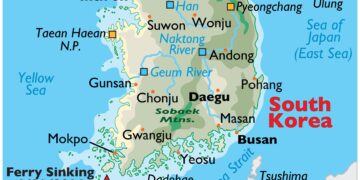In a decisive move to rejuvenate its beleaguered steel sector, South Korea is set to undertake a comprehensive restructuring of an industry grappling with the dual challenges of heavy tariffs and chronic oversupply. As global market dynamics shift and trade tensions intensify, the South Korean government is keenly aware of the crucial role that steel plays in its economy. With reports indicating that these factors have severely impacted profitability and competitiveness, the proposed restructuring seeks not only to stabilize the sector but also to lay the groundwork for long-term sustainability. This initiative comes at a pivotal time, as countries worldwide reassess their industrial strategies in the face of growing protectionist sentiments and changing demand patterns. The repercussions of South Korea’s actions will resonate across the global steel market, prompting stakeholders to closely monitor developments in this key industrial segment.
South Korea’s Steel Industry Faces New Challenges Amid Tariffs and Oversupply
South Korea’s steel sector is grappling with significant pressures as a result of both international tariffs and domestic oversupply. Increased protectionist measures by major trading partners have stymied exports, compelling local manufacturers to reassess their operational strategies. The government is now advocating for a comprehensive restructuring plan that focuses on improving competitiveness through innovation and diversification. Steelmakers are urged to:
- Enhance production efficiencies to reduce costs and optimize resource usage.
- Invest in advanced technologies to produce high-grade steel products that cater to niche markets.
- Shift towards greener practices to align with global sustainability standards.
Alongside tariff-induced challenges, local companies are facing a saturated market, which has led to price wars among manufacturers. This dynamic is further exacerbated by the influx of cheaper steel from other countries. To address these issues, industry stakeholders are focusing on collaborative efforts through:
- Strategic partnerships for research and development initiatives.
- Export alliances to navigate the complexities of global trade.
- Government support to facilitate access to new markets.
| Challenge | Impact | Proposed Solution |
|---|---|---|
| Tariffs | Reduced exports and market access | Restructuring and innovation |
| Oversupply | Increased competition and lower prices | Market diversification and strategic partnerships |
In-Depth Analysis of Tariff Impacts on Competitiveness and Market Dynamics
The recent move by South Korea to restructure its steel industry underscores the significant challenges presented by heavy tariffs and persistent oversupply in the global market. Tariffs, especially those imposed by major economies such as the United States, have created a ripple effect that impacts pricing and competitiveness. This action is essential for South Korean manufacturers aiming to regain a competitive edge while navigating a landscape where profitability has dwindled due to these external pressures. Key factors influencing this restructuring include:
- Increased Production Costs: Elevated raw material prices linked to tariffs.
- Reduced Export Opportunities: Limited access to traditional markets.
- Domestic Competition: The need to boost domestic consumption amid shrinking exports.
Furthermore, South Korea’s strategy appears aimed at enhancing operational efficiency and shifting focus toward value-added steel products rather than standard production. Adjustments in production capacity will likely involve consolidating smaller, underperforming facilities and investing in advanced manufacturing technologies. This directional shift can potentially elevate South Korea’s position in the global steel sector, emphasizing innovative and sustainable practices. The potential outcomes may include:
| Outcome | Impact |
|---|---|
| Reduced Oversupply | Balance between supply and demand. |
| Enhanced Competitiveness | Stronger positioning in global markets. |
| Sustainable Practices | Conformance with international environmental standards. |
Strategic Recommendations for Sustainable Growth and Innovation in Steel Manufacturing
To navigate the current challenges faced by the steel industry, including tariffs and oversupply, it is crucial for South Korean manufacturers to implement a comprehensive approach aimed at increasing operational efficiency and fostering innovation. Investment in advanced manufacturing technologies, such as automation and artificial intelligence, can streamline production processes, reduce costs, and enhance product quality. Moreover, forming strategic partnerships with tech firms can expedite the integration of innovative solutions and keep companies competitive in a rapidly evolving market.
Furthermore, a shift towards sustainability will not only comply with global environmental standards but also appeal to a growing consumer base that prioritizes eco-friendly products. Steel manufacturers should explore the following avenues:
- Developing low-carbon steel production methods.
- Investing in renewable energy sources for production processes.
- Implementing circular economy principles through recycling and waste management.
| Strategy | Expected Outcome |
|---|---|
| Automation & AI | Increased efficiency and reduced costs |
| Low-Carbon Technologies | Compliance with environmental regulations |
| Renewable Energy Investments | Lower carbon footprint and energy costs |
| Circular Economy Practices | Improved resource efficiency and waste reduction |
In Conclusion
In conclusion, South Korea’s strategic move to restructure its steel industry comes as a necessary response to the dual challenges of international tariffs and persistent oversupply. As the nation seeks to recalibrate its production capacities and bolster its competitiveness in the global market, industry stakeholders will be closely monitoring the effectiveness of these reforms. With a focus on innovation and sustainability, South Korea aims not only to fortify its local market but also to enhance its position in the worldwide steel sector. As developments unfold, the emphasis will likely remain on adaptability and resilience, key traits that may well define the future of South Korea’s steel industry in an increasingly complex economic landscape.














